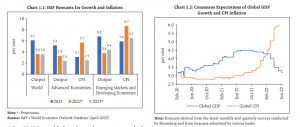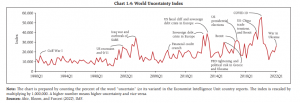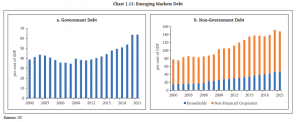
While a falling rupee and high inflation have been major concerns for the Indian economy, silver linings have started to emerge and it looks like the economy is on a path to recovery, the Reserve Bank of India said in a report on Thursday. Admitting that the country is currently facing spillovers from global conditions, the financial stability report says India’s financial system remains resilient and supportive of economic revival.
The banks and non-banking institutions have sufficient capital buffers and are capable of absorbing shocks, it says. The gross non-performing asset ratio (GNPA ratio) of banks is showing a declining trend. The GNPA ratio came down to a six-year low of 5.9% in March 2022 from 7.4% a year ago. However, there is a need to arrest further tumble of the rupee as it continues to hit historic lows and inflation creates pressure.
READ ALSO | Weak rupee will have a cascading effect on the Indian economy
Global crises impacting Indian economy
The ongoing Ukraine-Russia war has been a major deterrent to the growth of economies across the globe as import prices have shot up. Most visible change is in the fuel prices as Russia is a major exporter of fossil fuel. While other countries lost, Russia in fact earned close to $100 billion from exports of fossil fuels during the first 100 days of war with Ukraine, according to a report by Finland-based Centre for Research on Energy and Clean Air (CREA).
The rise in fuel import prices has a domino effect on inflation. With costlier fuel, pretty much every other industry faces an increase in raw material cost which translates into inflation in everyday use items. This dampens demand which causes low factory output. In June, India’s factory output expanded at its slowest pace in nine months. Elevated price pressures affected demand and output. Business confidence is also at its lowest in two years.


And then there is the rupee problem. The Indian currency touched its lowest on Wednesday and closed at 79.04 against the US dollar. Several factors are contributing to the problem including flight of foreign investment amid global worries over recession, rising interest rates in the US, and global inflation. The fall of the rupee does not augur well for the Indian economy which is already facing pressure of high inflation. The Indian currency has crashed 6.39% against the dollar since the beginning of 2022.
The rupee’s fall is a bigger problem to the common man, who now has to pay more not only for fuel, but also for almost everything he buys. Indians have to shell out more for foreign travel or studies. However, RBI says that the rupee is one of the currencies performing better than peers ever since the Ukraine war broke out in late February.
The war in Ukraine has added to the woes of the global economy which was yet to recover from the pains of the coronavirus pandemic. This holds especially true for the Indian economy which was not in the pinnacle of health even before the pandemic hit its shore. Due to the COVID-19 outbreak and the aftermath that followed, India witnessed a negative 6.6% growth in FY21. The second wave of coronavirus pandemic was a further blow to the economy and impeded growth momentum.
RBI report highlights silver linings
According to the RBI’s Financial Stability Report, accumulation of significant foreign exchange reserves over years has led to an improvement in several external vulnerability indicators vis-à-vis the taper tantrum period of 2013. This is a good sign that the country will be able to mitigate external risks and global spillovers.
India’s foreign exchange reserves added $30.3 billion thanks to net inflows of external commercial borrowings in the last fiscal year. The same reflects well on banking capital and has also led to sizable net foreign direct investment. The central bank also said that the current level of reserves in the country are comparable to nearly 10 months of imports projected for the current year even though the headline reserves have fallen to $590.6 billion as on June 17. This is a drop from an all-time high of $642.5 billion in September.

The positives highlighted by the report come at a time when the Indian economy is staring at lower growth and rising inflation, as well as a global economic crisis. The robust asset quality of the banks cannot be a guarantee for improved consumer demand and better investment demand from the private sector, which are essential conditions for higher economic growth.
RBI’s optimism for the Indian economy is good news until one ignores all indicators signalling a looming global recession in the coming months. And if the dreaded moment actually comes, India will be no exception, despite the central bank’s confidence in the Indian economy.

